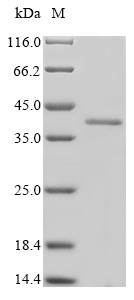Recombinant Mouse Survival motor neuron protein (Smn1) is produced using a mammalian cell expression system, which appears to ensure proper eukaryotic post-translational modifications and functionality. This full-length protein spans amino acids 1-288 and includes an N-terminal 10xHis tag plus a C-terminal Myc tag for purification and detection purposes. SDS-PAGE analysis indicates the protein reaches purity levels exceeding 85%, which should make it suitable for various research applications.
The survival motor neuron protein (Smn1) seems to play a critical role in assembling small nuclear ribonucleoproteins (snRNPs) - key components of the spliceosome complex. It participates in pre-mRNA splicing, a fundamental process in gene expression. Smn1's function is likely vital for cellular RNA processing and has become a focal point for understanding molecular mechanisms of RNA metabolism and related cellular pathways.
Potential Applications
Note: The applications listed below are based on what we know about this protein's biological functions, published research, and experience from experts in the field. However, we haven't fully tested all of these applications ourselves yet. We'd recommend running some preliminary tests first to make sure they work for your specific research goals.
Mouse SMN1 is a complex multi-domain protein that requires precise folding, proper oligomerization, and specific post-translational modifications for its function. While the mammalian cell expression system provides the optimal environment for eukaryotic protein folding, it does not guarantee 100% correct folding. The protein may achieve proper folding with high probability, but experimental validation is essential to confirm functional activity.
1. Protein-Protein Interaction Studies Using Pull-Down Assays
Authentic interactions depend on precise tertiary and quaternary structures that must be confirmed.
If correctly folded (Verified): Highly suitable for identifying physiological binding partners (e.g., Gemin proteins) with high confidence in results.
If Misfolded/Unverified: High risk of non-specific binding or failure to interact; results would be biologically misleading.
2. Antibody Development and Validation
Antibody development benefits from correct folding but can proceed based on sequence alone.
If Correctly Folded (Verified): Excellent for generating conformation-sensitive antibodies that recognize native SMN1.
If Misfolded/Unverified: Suitable for linear epitope antibodies only; may not recognize native protein.
3. Biochemical Characterization and Stability Studies
These studies are critical for determining the protein's quality and folding status.
If Correctly Folded (Verified): Essential for validating oligomerization state, stability, and functional complexes.
If Misfolded/Unverified: Still valuable for assessing physical properties, but characterizes non-native protein.
4. ELISA-Based Quantitative Assays
Assay accuracy depends on whether the standard matches the native protein conformation.
If Correctly Folded (Verified): Ideal for accurate quantification of native SMN1 in biological samples.
If Misfolded/Unverified: Suitable as a standard for detecting immunoreactive material, but may not reflect functional protein levels.
Final Recommendation & Action Plan
The mammalian expression system provides a high probability of correct folding, but rigorous validation is essential before functional applications. The immediate priority is Application 3 (Biochemical Characterization) to experimentally determine the protein's folding state and oligomerization capability through techniques like SEC-MALS, CD spectroscopy, and functional assays with known binding partners. If correct folding is verified, proceed with high confidence to Applications 1, 2, and 4 for interaction studies, antibody development, and quantitative assays. If misfolding is detected, limit applications to linear epitope antibody production and use as a quantitative standard with clear limitations. Always include appropriate controls and validation steps when using this reagent for functional studies.






